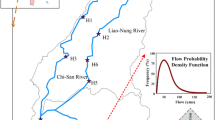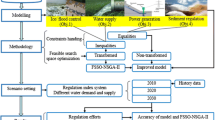Abstract
Population growth, urbanization and industrial expansion are consequentially linked to increasing pollution around the world. The sources of pollution are so vast and also include point and nonpoint sources, with intrinsic challenge for control and abatement. This paper focuses on pollutant concentrations and also the distance that the pollution is in contact with the river water as objective functions to determine two main necessary characteristics for water quality management in the river. These two necessary characteristics are named assimilative capacity and dilution flow. The mean area of unacceptable concentration \(\left( {\overline {{{c_a}}} } \right)\) and affected distance (X) are considered as two objective functions to determine the dilution flow by a non-dominated sorting genetic algorithm II (NSGA-II) optimization algorithm. The results demonstrate that the variation of river flow discharge in different seasons can modify the assimilation capacity up to 97%. Moreover, when using dilution flow as a water quality management tool, results reveal that the content of \(\left( {\overline {{{c_a}}} } \right)\) and X change up to 97% and 93%, respectively.






Similar content being viewed by others
References
Abbasi SA (1976) Extraction and spectrophotometric determination of vanadium (V) with N-[p-N,N dimethylanilino-3-methoxy 2-naphtho] hydroxamic acid. Anal Chem 48(4):714–717
Abbasi T, Abbasi SA (2012) Water-quality indices. Elsevier, Amsterdam
Abbasi SA, Soni R (1983) Stress-induced enhancement of reproduction in earthworm Octochaetus pattoni exposed to chromium (VI) and mercury (II)—implications in environmental management. Int J Environ Stud 22(1):43–47
Abbasi SA, Soni R (1984) Teratogenic effects of chromium (VI) in environment as evidenced by the impact on larvae of amphibian Rana tigrina: implications in the environmental management of chromium. Int J Environ Stud 23(2):131–137
Aboutalebi M, Bozorg Haddad O, Loáiciga AH (2016) Simulation of methyl tertiary butyl ether concentrations in river-reservoir systems using support vector regression. J Irrig Drain Eng 142(6):04016015
ACWG (2004) Strategic framework for Scottish aquaculture: carrying capacity. A priority for action. Assimilative capacity working group report. Scottish Environment Protection Agency, Dingwall
Bozorg Haddad O, Beygi S, Marino M (2014) Reservoir water allocation under abrupt pollution condition. J Irrig Drain Eng 140(3):04013017
Cairns J Jr (1977) Aquatic ecosystem assimilative capacity. Fisheries 2:5–13
Chen Q, Wu W, Blanckaert K, Ma J, Huang G (2012) Optimization of water quality monitoring network in a large river by combining measurements, a numerical model and matter-element analysis. J Environ Manage 110:116–124
Clarke AN, Jan-Tai K, Rosten PW, Vantrease L, Zielger FG (1980) Water quality modeling and wasteload allocation analysis for the Calcasieu Estuary. The Aware Corporation, Nashville
Colman JA, Massey AJ, Levin SB (2011) Determination of dilution factors for discharge of aluminum containing wastes. Public water-supply treatment facilities into lakes and reservoirs in Massachusetts. Prepared in cooperation with the Massachusetts Department of Environmental Protection Scientific, Reston
De Smedt F, Brevis W, Debels P (2005) Analytical solution for solute transport resulting from instantaneous injection in streams with transient storage. J Hydrol 315:25–39
De Andrade LN, Mauri GR, Mendonça ASF (2013) General multi objective model and simulated annealing algorithm for waste-load allocation. J Water Resour Plann Manage 139(3):339–344
Deb K, Pratap A, Agarwal S, Meyarivan TAMT (2002) A fast and elitist multiobjective genetic algorithm: NSGA-II. IEEE Trans Evol Comput 6(2):182–197
Executive Summary (2006) Assimilative capacity studies for the Lake Simcoe Watershed and Nottawasaga River
Fallah-Mehdipour E (2015) Discussion of “Assimilative capacity and flow dilution for water quality protection in rivers. J Hazard Toxic Radioact Waste 19(3):07015001
Fallah-Mehdipour E, Haddad OB, Mariño MA (2012a) Real-time operation of reservoir system by genetic programming. Water Resour Manag 26(14):4091–4103
Fallah-Mehdipour E, Haddad OB, Tabari MMR, Mariño MA (2012b) Extraction of decision alternatives in construction management projects: application and adaptation of NSGA-II and MOPSO. Expert Syst Appl 39(3):2794–2803
Farhadian M, Bozorg Haddad O, Seifollahi Aghmiuni S, Loáiciga AH (2014) Assimilative capacity and flow dilution for water quality protection in rivers. J Hazard Toxic Radioact Waste 19(2):04014027
Fischer HB (1975) Discussion of simple method for predicting dispersion in streams by McQuivey and Keefer. J Environ Eng 101:453–455
GESAMP (1986) Environmental capacity. An approach to marine pollution preventation. No. 30
Gillibrand PA (2006) Improving assimilative capacity modelling for Scottish Coastal Waters: II. A model of physical exchange for open water sites. Funded by the Scottish Aquaculture Research Forum. Marine Physics Report No. 168
Glasoe S, Steiner F, Budd W, Young G (1990) Assimilative capacity and water resource management: four examples from the united States. Landscape Urban Plann 19:17–46
Hashemi Monfared SA, Dehghani Darmian M (2016) Evaluation of appropriate advective transport function for one-dimensional pollutant simulation in rivers. Int J Environ Res 10(1):77–84
Hashemi Monfared SA, Mirbagheri SA, Sadrnejad SA (2014) A three-dimensional, integrated seasonal separate advection—diffusion model (ISSADM) to predict water quality patterns in the chahnimeh reservoir. Environ Model Softw 19(1):71–83
Hashemi Monfared SA, Dehghani Darmian M, Pirzadeh B, Azhdary Moghaddam M (2016) Water quality prediction in one-dimensional flow by means of new advective transport function and convergence criteria modification. J Water Soil Conserv 23(2):147–162
Joardar SD (1998) Carrying capacities and standards as bases towards urban infrastructure planning in India: A Case of urban water supply and sanitation. Urban Infrastruct Plan India 22:327–337
Karamouz M, Kerachian R, Mahmoodian M (2003) Seasonal waste-load allocation model for river water quality management: application of sequential dynamic genetic algorithms. World Water and Environmental Resources Congress, ASCE, Reston
Keeling AM (2007) Charting marine pollution science: oceanography on Canada’s Pacific coast, 1938–1970. J Hist Geogr 33:403–428
Landis WG (2008) Defining Assimilative Capacity Application of Assimilative Capacity to the TMDL Process. USEPA (1999) Protocol for Developing Nutrient TMDLs, Elsevier B.V. All rights reserved. pp 264–268
Landner L (1994) How do we know when we have done enough to protect the environment? Mar Pollut Bull 29:593–598
Landner L, Grahn O, Hardig J, Lehtinen KJ, Monfelt C, Tana J (1994) A field study of environmental impacts at a bleached kraft pulp mill site on the Baltic Sea coast. Ecotoxicol Environ Safety 27:128–157
Loucks DP, van beek E (2005) Water resources systems planning and management. UNESCO, Italy
Mahmoudi N, Orouji H, Fallah-Mehdipour E (2016) Integration of shuffled frog leaping algorithm and support vector regression for prediction of water quality parameters. Water Resour Manage 30(7):2195–2211
Maruya KA, Schlenk D, Anderson PD, Denslow ND, Drewes JE, Olivieri AW, Scott GI, Snyder SA (2014) An adaptive, comprehensive monitoring strategy for chemicals of emerging concern (CECs) in California’s aquatic ecosystems. Integr Enviro Assess Manage 10(1):69–77
Murray HE, Beck JN (1990) Concentrations of selected chlorinated pesticides in shrimp collected from the Calcasieu river/lake complex, Louisiana. Bull Environ Contam Toxicol 44:798–804
Nigel WT, Quinn PE (2005) Advancing the concept of real-time water quality management in the San Joaquin Basin Hydro Ecological Engineering Advanced Decision Support Berkeley National Laboratory. Berkeley, CA CWEMF Annual Meeting Asilomar, California
Saha N, Safiur Rahmanb M, Boshir Ahmedc M, Zhouc L, Hao Ngoc J, Guoc H W (2017) Industrial metal pollution in water and probabilistic assessment of human health risk. J Environ Manage 185:70–78
Schmalle GF, Rehmann CR (2014) Analytical solution of a model of contaminant transport in the advective zone of a river. J Hydraul Eng 140(7):04014029
Seifollahi Aghmiuni S, Bozorg Haddad O, Farhadian M, Loáiciga AH (2015) Closure to “assimilative capacity and flow dilution for water quality protection in rivers. J Hazard Toxic Radioact Waste 19(3):07015002
Seo IW, Cheong TS (1998) Predicting longitudinal dispersion coefficient in natural streams. J Hydraul Eng 124(1):25–32
Shokri A, Bozorg Haddad O, Marino M (2014) Multi-objective quantity-quality reservoir operation in sudden pollution. Water Resour Manage 28:567–586
Spanou M, Chen D (2000) An object-oriented tool for the control of point-source pollution in river systems. Environ Model Softw 15:35–54
Strehmel A, Schmalz B, Fohrer N (2016) Evaluation of land use, land management and soil conservation strategies to reduce non-point source pollution loads in the three gorges region, China. Environ Manage 58:906–921
Tana J, Rosemarin A, Lehtinen KJ, Hardig J, Grahn O, Landner L (1994) Assessing impacts on Baltic coastal ecosystems with mesocosms and fish biomarker tests: a comparison of new and old wood pulp bleaching technologies. Sci Total Environ 145:213–234
Technical memorandum (2004) Brockville water pollution control center. Assimilative capacity analysis
Tett P, Portilla E, Inall M, Gillibrand P, Gubbins M, Amundrod T (2007) Modelling the assimilative capacity of sea-lochs (Final Report on SARF 012)
U.S. Department of the Interior, U.S. Geological Survey. Investigations Report 2011–5136
van Genuchten MTh, Alves WJ (1982) Analytical solutions of the one-dimensional convective-dispersive solute transport equation. U.S. Department of Agriculture, Technical Bulletin, 1661:1–151
Wang T (1991) Assimilation of Malathion in the Indian River Estuary, Florida. Bull Environ Contain Toxicol 47:238–243
Wen CG, Lee CS (1998) A neural network approach to multi objective optimization for water quality management in a river basin. Water Resour Res 34(3):427–436
Wu M, Tang X, Li Q, Yang W, Jin F, Tang M, Scholz M (2013) Review of ecological engineering solutions for rural non-point source water pollution control in Hubei province, China. J Water Air Soil Pollut 224(5):1–18
Yandamuri SR, Srinivasan K, Bhallamudi SM (2006) Multi objective optimal waste load allocation models for rivers using nondominated sorting genetic algorithm-II. J Water Resour Plann Manage 132(3):133–143
Zhang K, Su F, Liu X, Song Z, Feng X (2017) Heavy metal concentrations in water and soil along the Hun River, Liaoning, China. Bull Environ Contam Toxicol 99:391–398
Author information
Authors and Affiliations
Corresponding author
Electronic supplementary material
Below is the link to the electronic supplementary material.
Rights and permissions
About this article
Cite this article
Hashemi Monfared, S.A., Dehghani Darmian, M., Snyder, S.A. et al. Water Quality Planning in Rivers: Assimilative Capacity and Dilution Flow. Bull Environ Contam Toxicol 99, 531–541 (2017). https://doi.org/10.1007/s00128-017-2182-7
Received:
Accepted:
Published:
Issue Date:
DOI: https://doi.org/10.1007/s00128-017-2182-7




